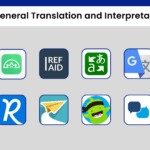Digital Inclusion is a new focus area for Switchboard, with a new team! Freschta Naseri, Digital Inclusion Coordinator, brings over 5 years’ experience in resettlement services and comes to the team from the IRC Dallas office. Julie Heller, Digital Inclusion Manager, brings over 25 years’ experience in media and education and comes to the team from the IRC Salt Lake City office.
Together, this team will support the development of new digital inclusion resources, including webinars, podcasts, downloadable resources, in-person events, and blog posts like this. Below, they discuss the importance of digital inclusion, the challenges that often arise when trying to implement it, and the best strategies to help mitigate those challenges.
What is Digital Inclusion?
Navigating the digital world is essential for newcomers in the U.S.—it enables them to access educational and employment opportunities critical for their resettlement. However, restricted access to affordable technological devices and broadband internet, alongside limited digital literacy skills, can pose overwhelming challenges.
Digital inclusion seeks to address these barriers by providing equal access to computer technology, as well as to the skills required to use it effectively. Bridging the digital gap means providing support for newcomers in three main areas—a three-legged-stool. The first leg is affordable, robust broadband internet services; the second leg is internet-enabled devices; and the final leg is access to digital literacy skill building that empowers newcomers to navigate the digital world safely and confidently.

Below, we explore some of the strategies U.S. service providers have deployed to overcome challenges in these three key areas.
1. Affordable Internet
Since 2021, more than $14 billion has been appropriated for the Affordable Connectivity Program (ACP), providing internet services to 22 million households. But ACP enrollments have been suspended—as of February 7, 2024, enrollees are no longer being processed—and ACP funds are scheduled to run out by May 1, 2024. Millions of people who participated in this program may be without service, including newcomers.
Several options are available to help fill this void:
- The Federal Communications Commission’s Lifeline program provides a discount on phone service for qualifying low-income consumers. The Lifeline program is available to eligible low-income consumers in every state, territory, and commonwealth, as well as on tribal lands.
- The EveryoneOn platform curates and features low-cost Internet Service Providers (ISPs) and affordable computers for communities who need it.
- Mobile tethering allows a smartphone to function as a Wi-Fi router and share its internet connection. This option requires that clients carefully review their cellular data plans, or else they could face hefty unforeseen data charges.
- Local libraries often offer hotspots with a three-week checkout period, providing a convenient solution for temporary internet needs.
- Internet Service Providers (ISPs) programs frequently sponsor local programs tailored to emerging community needs, such as T-Mobile’s Project10Million, which partners with school districts to deliver free internet connection to underserved student households. Many ISPs also offer low-cost internet programs for eligible households—Access by AT&T, Connect2Compete by Cox Communications, Internet Essentials by Comcast, Internet Assist by Spectrum, Verizon Forward, and Connect2Compete by Mediacom are all options. To benefit from such programs, clients must live in areas covered by the offering ISP and meet the specific eligibility criteria. Find your local ISP at: Providers Near Me.
- Public school districts commonly provide Wi-Fi options for students’ home use, ensuring educational resources are accessible outside of school.
- The Broadband Equity, Access, and Deployment (BEAD) program is set to inject over $42 billion in funding over the next 4 years to expand internet services across the U.S.
If your clients currently participate in ACP, make sure their email addresses are up to date to communicate future changes in the ACP program and share helpful resources. For more information, check out the ACP homepage at AffordableConnectivity.gov as well as this ACP wind-down fact sheet.
2. Access to Technological Devices
To participate fully in 21st century life, newcomers need sustained access to computers and digital devices, which are often prohibitively expensive. We reached out to service providers across the nation—organizations like Dottie Rose, Immigrant Legal Center, Centro Hispano, the University of Kansas, and Afro Village—who have had some success in connecting newcomers with affordable computer technology. They offered the following guidance:
- Connect with national and local non-profit organizations that offer free or low-cost computers. These computers are usually refurbished donations, and clients may be subject to eligibility and residency requirements. Examples include Computers with Causes, Connect All, and the On It Foundation.
- Engage with for-profit companies to inquire if they rotate out computers every few years and would be willing to donate resources. Banks, healthcare facilities, and universities are all great places to start.
- Contact your local e-recycling company, as many have established programs for refurbishing and distributing devices to those in need. PCs for People is a great example of such a program.
- Visit local libraries to discuss innovative potential partnerships—perhaps a publicly-funded digital instruction course which provides clients with relevant technology upon completion.
- Actively participate in charitable giving events like Giving Tuesday, which can help source new donor funds for the technological inventory clients need.
- Diversify your funding and procurement methods. By connecting with government officials, non-profits, large companies, public schools, and private individual donors alike, you both maximize your odds of success and help make that success sustainable.
3. Digital Literacy
Expanding digital literacy among newcomers is critical. While urgent needs, like resolving employment or immigration issues, may seem higher-priority in the short term, newcomers’ ability to complete computer-based tasks and navigate online networks play a major role in their long-term resettlement success.
But digital literacy instruction comes with key challenges, from client literacy to cultural and language barriers. With these issues in mind, below are some best practices for a successful approach to digital literacy instruction:
Student-Centered, Strengths-Based Instruction
Working with students of varying literacy levels and experiences requires custom strategies, tailored to clients’ relevant needs, strengths, and barriers. To empower students with a student-centered, strengths-based approach:
- Conduct a comprehensive needs assessment to understand and support clients’ educational goals within the context of their daily lives;
- Provide flexible accommodations such as varied class scheduling, online and in-person class options, one-on-one and group class formats, late evening or weekend class times, transportation assistance for in-person classes, and on-demand technical support;
- Seek feedback from clients on a recurring basis, evolving instruction based on clients’ preferred learning styles; and
- Design a welcoming, respectful, and supportive learning environment to promote a sense of belonging among clients.
For a detailed review of student-centered, strengths-based strategies, see: Overcoming Barriers to Adult Education: Strengths-Based Strategies for Effective Enrollment and Retention
Cultural Awareness in Digital Inclusion Programming
Embracing the richness of students’ diverse backgrounds requires a comprehensive approach that celebrates and leverages their unique cultural identities. Educators and service providers can:
- Prioritize cultural awareness;
- Respect and value cultural diversity in all interactions;
- Learn about refugee cultures, home countries, histories, and experiences;
- Reference online support resources like Switchboard, which provides extensive materials on Identity and Inclusive Services; and
- Employ multicultural/multilingual staff and volunteers in digital literacy learning environments.
To learn more, see: Cultural Competence in Refugee Service Settings.
Want to Learn More?
Employing strategies in all three categories of digital inclusion—broadband, devices, and digital literacy—will have the greatest efficacy in helping newcomers navigate a digital world. See the Switchboard resources below to learn more. To request digital inclusion technical assistance from Switchboard, please fill out a Technical Assistance Request.
- Archived webinar: Digital Skills In Refugee Integration: Lessons Learned From Research And Practice (2021)
- Evidence summary: What Works To Improve Digital Inclusion Among Resettled Refugees? (2021)
- Information guide: Integrating Digital Citizenship Into Refugee And Immigrant Youth Programs (2020)
- Potocky, M. (2022). Role of Digital Skills in Refugee Integration. The International Journal of Information, Diversity, & Inclusion (IJIDI), 5(5).








